New Features in Angular Signals and RxJS
1) Signals vs RxJS: Creating a Signal variable from scratch in Angular 16 and comparing it to an Observable.
With an example where we have a sidebar menu and a top menu, every time we press a button, the top menu will tell the sidebar menu to collapse:

With RxJS:
This communication is done in a service using a subject and an observable, where every time we click the button, a next is called, which passes the emitted value to the subscribed observable. The sidebar menu component will simply be subscribed and will use this property in the HTML. First, we create the Subject in the service, then we create the observable from it, and we call next to pass the emitted value:
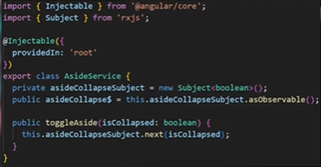
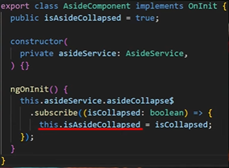
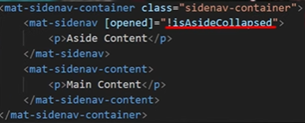
With Signals:
This can be done simply with Signals. Signals were created in Angular to achieve better performance in certain simpler cases. They are imported from @angular/core.
You need to declare a Signal, and every time we update that signal, we call set on it. In the sidebar menu component, we just have to reference that property, and to use the signal in the HTML, we need to put parentheses around it to get its value, as this is how signals are used.
We can also perform an update, which has the added benefit of telling us the previous value. For this, we specify that it receives the previous value and its type, and with an arrow function, we indicate the new value, which is the negated new value:
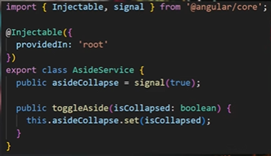

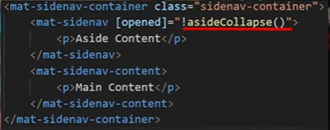
There are also ways to convert observables to signals and signals to observables:

It's not that signals are a replacement for subjects, as both, along with observables, are much more powerful and have many more features, such as RxJS operators (we have much more control with RxJS). However, signals provide a simple way to work and are common with other libraries and frameworks.
RxJS is a library from Microsoft, not Angular. In contrast, Signals is a library from Angular, which provides greater control and performance, as it allows Angular to know exactly which part has changed when a state changes. This avoids having to re-render the entire component, focusing only on that specific part.
2) New simplified way to unsubscribe with takeUntilDestroyed from RxJS in Angular 16.
In Angular, it's important to unsubscribe from observables. In an example, in OnInit, we store a subscription, and in OnDestroy, we unsubscribe.
The old way was to store a variable with the subscription, and at the time of subscribing, save it in that variable and destroy that subscription in OnDestroy:
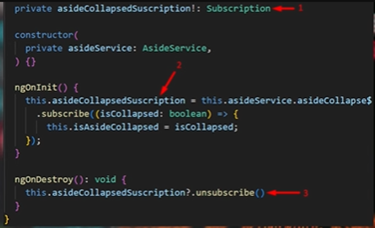
Detailed Explanation: A property of type Subscription (from RxJS) is created. This property is initialized in ngOnInit, assigning it the reference of the subscription when it is made. Then, in ngOnDestroy, the subscription is canceled. If the component hasn't defined the subscription variable, it's necessary to handle the error, either by using a question mark to check if it is defined or through a conditional.
Now, this can be done more simply, without creating OnDestroy or a subscription variable, by using the RxJS operator takeUntilDestroyed. What this does is automatically cancel the subscription when the component is about to be destroyed. It is important to inject the DestroyRef service and pass it, so it knows when the component is destroyed:
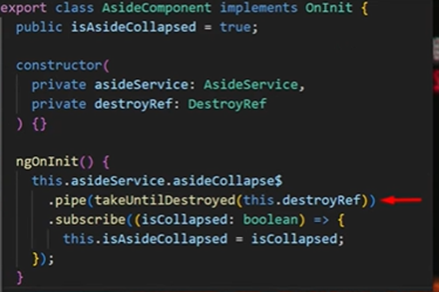
Detailed Explanation: Now, in the case where we are not unsubscribing, we add an RxJS pipe and send it a takeUntilDestroyed(), a NEW operator, which requires us to pass a destroyedRef, which is a service (from @angular/core) that we can inject into the constructor.
Example: In a sidebar service, it listens for a button click in the navbar component. With takeUntilDestroyed(), it unsubscribes only when the component is destroyed, avoiding multiple subscriptions. In this case, we always want to listen to whether the button has been pressed or not; therefore, we only want to unsubscribe if the component is destroyed.
This is important to do, as otherwise, it will be listening even if we are in other components, and it will only unsubscribe if we close the app since the component is destroyed. This is crucial because if it is always active, when navigating through page components, for example, in the first navigation, it subscribes, then we navigate to another page, and when we return to the first page, it would be a second subscription, resulting in two active subscriptions. Thus, it is important to unsubscribe.
An important note: when we subscribe to an HTTP request, it is not necessary to unsubscribe, as this is done automatically.
3) Effect of a Signal in Angular. Listening for changes in a Signal.
In an example, we have a Signal that returns a boolean and in a method below, it updates with an update:
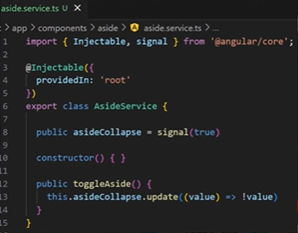
Imagine you want to be alerted whenever the signal changes, but it changes from many places, not just from this method. If we want to do something whenever it changes, we can do this with an effect. This function takes a signal and checks if it changes to automatically execute the method within the effect:
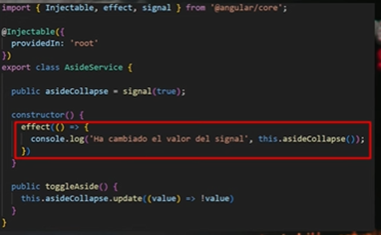
With this, for example, instead of a console log, we can save the value in local storage and instantiate it with that value. This is especially useful when working with code that we do not know and are unsure how many places it is being modified from.
— Notes based on the Angular course from EfisioDev —
-
 Beyond `if` Statements: Where Else Can a Type with an Explicit `bool` Conversion Be Used Without Casting?Contextual Conversion to bool Allowed Without a CastYour class defines an explicit conversion to bool, enabling you to use its instance 't' di...Programming Published on 2025-01-14
Beyond `if` Statements: Where Else Can a Type with an Explicit `bool` Conversion Be Used Without Casting?Contextual Conversion to bool Allowed Without a CastYour class defines an explicit conversion to bool, enabling you to use its instance 't' di...Programming Published on 2025-01-14 -
 What Happened to Column Offsetting in Bootstrap 4 Beta?Bootstrap 4 Beta: The Removal and Restoration of Column OffsettingBootstrap 4, in its Beta 1 release, introduced significant changes to the way column...Programming Published on 2025-01-14
What Happened to Column Offsetting in Bootstrap 4 Beta?Bootstrap 4 Beta: The Removal and Restoration of Column OffsettingBootstrap 4, in its Beta 1 release, introduced significant changes to the way column...Programming Published on 2025-01-14 -
 How do I combine two associative arrays in PHP while preserving unique IDs and handling duplicate names?Combining Associative Arrays in PHPIn PHP, combining two associative arrays into a single array is a common task. Consider the following request:Descr...Programming Published on 2025-01-14
How do I combine two associative arrays in PHP while preserving unique IDs and handling duplicate names?Combining Associative Arrays in PHPIn PHP, combining two associative arrays into a single array is a common task. Consider the following request:Descr...Programming Published on 2025-01-14 -
 How to Insert and Retrieve java.time.LocalDate Objects in JDBC Databases?Inserting & Fetching java.time.LocalDate Objects to/from an SQL Database Like H2Question: How to handle java.time types like LocalDate via JDBC with a...Programming Published on 2025-01-14
How to Insert and Retrieve java.time.LocalDate Objects in JDBC Databases?Inserting & Fetching java.time.LocalDate Objects to/from an SQL Database Like H2Question: How to handle java.time types like LocalDate via JDBC with a...Programming Published on 2025-01-14 -
 Using WebSockets in Go for Real-Time CommunicationBuilding apps that require real-time updates—like chat applications, live notifications, or collaborative tools—requires a communication method faster...Programming Published on 2025-01-14
Using WebSockets in Go for Real-Time CommunicationBuilding apps that require real-time updates—like chat applications, live notifications, or collaborative tools—requires a communication method faster...Programming Published on 2025-01-14 -
 How Can I Find Users with Today\'s Birthdays Using MySQL?How to Identify Users with Today's Birthdays Using MySQLDetermining if today is a user's birthday using MySQL involves finding all rows where ...Programming Published on 2025-01-14
How Can I Find Users with Today\'s Birthdays Using MySQL?How to Identify Users with Today's Birthdays Using MySQLDetermining if today is a user's birthday using MySQL involves finding all rows where ...Programming Published on 2025-01-14 -
 How Do I Store Unicode Data in MySQL?Unicode Storage in MySQLIn MySQL, Unicode storage is accommodated through the use of appropriate character sets. Unlike SQL Server's nvarchar type...Programming Published on 2025-01-14
How Do I Store Unicode Data in MySQL?Unicode Storage in MySQLIn MySQL, Unicode storage is accommodated through the use of appropriate character sets. Unlike SQL Server's nvarchar type...Programming Published on 2025-01-14 -
 Why Does Passing a Const Object to a Non-Const Member Function Cause a Qualifier Disqualification Error in C++?Passing Const Objects as 'this' Argument: Qualifier Disqualification ErrorIn C , passing const objects as 'this' arguments to member ...Programming Published on 2025-01-14
Why Does Passing a Const Object to a Non-Const Member Function Cause a Qualifier Disqualification Error in C++?Passing Const Objects as 'this' Argument: Qualifier Disqualification ErrorIn C , passing const objects as 'this' arguments to member ...Programming Published on 2025-01-14 -
 Circle Cursor Js #GSAPA simple JavaScript script to create an interactive circular cursor for personal projects. Lightweight and easy to integrate, it enhances the visual e...Programming Published on 2025-01-13
Circle Cursor Js #GSAPA simple JavaScript script to create an interactive circular cursor for personal projects. Lightweight and easy to integrate, it enhances the visual e...Programming Published on 2025-01-13 -
 How Can I Retrieve MySQL Column Names Using a SQL Query?Retrieving Column Names from a MySQL Table Using a SQL QueryTo extract all column names from a MySQL table into an array in PHP, the following SQL que...Programming Published on 2025-01-13
How Can I Retrieve MySQL Column Names Using a SQL Query?Retrieving Column Names from a MySQL Table Using a SQL QueryTo extract all column names from a MySQL table into an array in PHP, the following SQL que...Programming Published on 2025-01-13 -
 Back to Top button with smooth scrollThe "Back to Top" button on long pages is a simple and useful navigation feature. This button allows users to quickly return to the top of ...Programming Published on 2025-01-12
Back to Top button with smooth scrollThe "Back to Top" button on long pages is a simple and useful navigation feature. This button allows users to quickly return to the top of ...Programming Published on 2025-01-12 -
 Why Can\'t Non-Constant Variables Be Used as Template Arguments in C++?Why Can't a Non-Constant Variable be Passed as a Template Argument?In C , template arguments must be constant expressions. This means that their ...Programming Published on 2025-01-12
Why Can\'t Non-Constant Variables Be Used as Template Arguments in C++?Why Can't a Non-Constant Variable be Passed as a Template Argument?In C , template arguments must be constant expressions. This means that their ...Programming Published on 2025-01-12 -
 How Can Go\'s `context` Package Be Used to Timeout Goroutines?How Does Go Handle Timing Out Goroutines?Question:You are building a tool that handles multiple HTTP calls in concurrent goroutines. To prevent an ind...Programming Published on 2025-01-12
How Can Go\'s `context` Package Be Used to Timeout Goroutines?How Does Go Handle Timing Out Goroutines?Question:You are building a tool that handles multiple HTTP calls in concurrent goroutines. To prevent an ind...Programming Published on 2025-01-12 -
 How to Properly Split Java Strings on a Literal Dot Using Escape Sequences?Using Escape Sequence to Split Java Strings on Literal DotWhen attempting to split a Java string on a literal dot (".") using the split() me...Programming Published on 2025-01-12
How to Properly Split Java Strings on a Literal Dot Using Escape Sequences?Using Escape Sequence to Split Java Strings on Literal DotWhen attempting to split a Java string on a literal dot (".") using the split() me...Programming Published on 2025-01-12 -
 Daily JavaScript Challenge #JS- Find the Longest Common PrefixDaily JavaScript Challenge: Find the Longest Common Prefix Hey fellow developers! ? Welcome to today's JavaScript coding challenge. Let&#...Programming Published on 2025-01-11
Daily JavaScript Challenge #JS- Find the Longest Common PrefixDaily JavaScript Challenge: Find the Longest Common Prefix Hey fellow developers! ? Welcome to today's JavaScript coding challenge. Let&#...Programming Published on 2025-01-11
Study Chinese
- 1 How do you say "walk" in Chinese? 走路 Chinese pronunciation, 走路 Chinese learning
- 2 How do you say "take a plane" in Chinese? 坐飞机 Chinese pronunciation, 坐飞机 Chinese learning
- 3 How do you say "take a train" in Chinese? 坐火车 Chinese pronunciation, 坐火车 Chinese learning
- 4 How do you say "take a bus" in Chinese? 坐车 Chinese pronunciation, 坐车 Chinese learning
- 5 How to say drive in Chinese? 开车 Chinese pronunciation, 开车 Chinese learning
- 6 How do you say swimming in Chinese? 游泳 Chinese pronunciation, 游泳 Chinese learning
- 7 How do you say ride a bicycle in Chinese? 骑自行车 Chinese pronunciation, 骑自行车 Chinese learning
- 8 How do you say hello in Chinese? 你好Chinese pronunciation, 你好Chinese learning
- 9 How do you say thank you in Chinese? 谢谢Chinese pronunciation, 谢谢Chinese learning
- 10 How to say goodbye in Chinese? 再见Chinese pronunciation, 再见Chinese learning

























